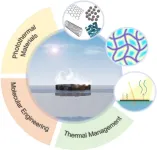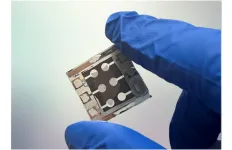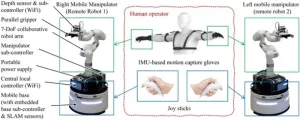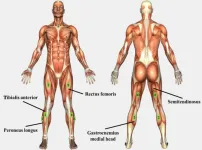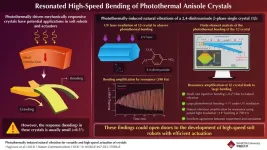(Press-News.org) ANN ARBOR—The "spooky action at a distance" that once unnerved Einstein may be on its way to being as pedestrian as the gyroscopes that currently measure acceleration in smartphones.
Quantum entanglement significantly improves the precision of sensors that can be used to navigate without GPS, according to a new study in Nature Photonics.
"By exploiting entanglement, we improve both measurement sensitivity and how quickly we can make the measurement," said Zheshen Zhang, associate professor of electrical and computer engineering at the University of Michigan and co-corresponding author of the study. The experiments were done at the University of Arizona, where Zhang was working at the time.
Optomechanical sensors measure forces that disturb a mechanical sensing device that moves in response. That motion is then measured with light waves. In this experiment, the sensors were membranes, which act like drum heads that vibrate after experiencing a push. Optomechanical sensors can function as accelerometers, which can be used for inertial navigation on a planet that doesn't have GPS satellites or within a building as a person navigates different floors.
Quantum entanglement could make optomechanical sensors more accurate than inertial sensors currently in use. It could also enable optomechanical sensors to look for very subtle forces, such as identifying the presence of dark matter. Dark matter is invisible matter believed to account for five times more of the mass in the universe than what we can sense with light. It would tug on the sensor with gravitational force.
Here's how entanglement improves optomechanical sensors:
Optomechanical sensors rely on two synchronized laser beams. One of them is reflected from a sensor, and any movement in the sensor changes the distance that the light travels on its way to the detector. That difference in distance traveled shows up when the second wave overlaps with the first. If the sensor is still, the two waves are perfectly aligned. But if the sensor is moving, they create an interference pattern as the peaks and troughs of their waves cancel each other out in places. That pattern reveals the size and speed of vibrations in the sensor.
Usually in interferometry systems, the further the light travels, the more accurate the system becomes. The most sensitive interferometry system on the planet, the Laser Interferometer Gravitational-Wave Observatory, sends light on 8-kilometer journeys. But that's not going to fit in a smartphone.
To enable high accuracy in miniaturized optomechanical sensors, Zhang's team explored quantum entanglement. Rather than splitting the light once so that it bounced off a sensor and a mirror, they split each beam a second time so that the light bounced off two sensors and two mirrors. Dalziel Wilson, an assistant professor of optical sciences at the University of Arizona, along with his doctoral students Aman Agrawal and Christian Pluchar, built the membrane devices. These membranes, just 100 nanometers—or 0.0001 millimeters—thick, move in response to very small forces.
Doubling the sensors improves the accuracy, as the membranes should be vibrating in sync with each other, but the entanglement adds an extra level of coordination. Zhang's group created the entanglement by "squeezing" the laser light. In quantum mechanical objects, such as the photons that make up light, there is a fundamental limit on how well the position and momentum of a particle can be known. Because photons are also waves, this translates to the phase of the wave (where it is in its oscillation) and its amplitude (how much energy it carries).
"Squeezing redistributes the uncertainty, so that the squeezed component is known more precisely, and the anti-squeezed component carries more of the uncertainty. We squeezed the phase because that is what we needed to know for our measurement," said Yi Xia, a recent Ph.D. graduate from Zhang's lab at the University of Arizona and co-corresponding author of the paper.
In squeezed light, the photons are more closely related to one another. Zhang contrasted what happens when the photons go through a beam splitter with cars coming to a fork in the freeway.
"You have three cars going one way and three cars going the other way. But in quantum superposition, each car goes both ways. Now the cars on the left are entangled with the cars on the right," he said.
Because the fluctuations in the two entangled beams are linked, the uncertainties in their phase measurements are correlated. As a result, with some mathematical wizardry, the team was able to get measurements that are 40% more precise than with two unentangled beams, and they can do it 60% faster. What's more, the precision and speed is expected to rise in proportion to the number of sensors.
"It is envisioned that an array of entanglement-enhanced sensors will offer orders-of-magnitude performance gain over existing sensing technology to enable the detection of particles beyond the present physical model, opening the door to a new world that is yet to be observed," said Zhang.
The team's next steps are to miniaturize the system. Already, they can put a squeezed-light source on a chip that is just half a centimeter to a side. They expect to have a prototype chip with the squeezed-light source, beam splitters, waveguides and inertial sensors within a year or two.
The study was funded by the Office of Naval Research, National Science Foundation, Department of Energy and Defense Advanced Research Projects Agency.
Study (available when embargo lifts): Entanglement-enhanced optomechanical sensing (DOI: 10.1038/s41566-023-01178-0)
END
Quantum entanglement could make accelerometers and dark matter sensors more accurate
And yes, they are looking to miniaturize it for smartphone dead reckoning
2023-04-20
ELSE PRESS RELEASES FROM THIS DATE:
Opportunities and challenges for geological and hydrogeological work in China in the new era
2023-04-20
The paper is an important speech made by Min Wang, Vice Minister of the former Ministry of Land and Resources of the PRC, at the seminar “Groundwater and Healthy & Green Development”, which indicated the problems of geological and hydrogeological work over the past decades, and what should we do next. Although significant progress in geological work has been made in China, there are still many challenges need to be done, “going one step further” is very important. It is necessary to promote the transformation of geological work, ...
Research team publishes review study of interfacial solar evaporation systems
2023-04-20
Freshwater is essential for human life and the scarcity of freshwater is a critical issue in parts of the world today. In recent years, scientists have put great efforts into developing desalination technologies so that clean water can be produced from seawater. Interfacial solar evaporation (ISE) is a technology that holds promise for helping to relieve worldwide freshwater shortages. A team of researchers has undertaken a review study of the strategies available for constructing efficient ISE systems.
Their ...
Sleeping pill reduces levels of Alzheimer’s proteins
2023-04-20
Sleep disturbances can be an early sign of Alzheimer’s disease. Many people eventually diagnosed with Alzheimer’s start experiencing difficulty falling and staying asleep years before cognitive problems such as memory loss and confusion emerge. It’s a vicious cycle: Alzheimer’s disease involves changes to the brain that disrupt sleep, and poor sleep accelerates harmful changes to the brain.
Researchers at Washington University School of Medicine in St. Louis have identified a possible way to help break that cycle. A small, two-night study has shown that people who took a sleeping pill before bed experienced a drop in the levels of key Alzheimer’s ...
One-step solution-coating method to advance perovskite solar cell manufacturing and commercialization
2023-04-20
Perovskite solar cells (PSCs) are considered a promising candidate for next-generation photovoltaic technology with high efficiency and low production cost, potentially revolutionizing the renewable energy industry. However, the existing layer-by-layer manufacturing process presents challenges that have hindered the commercialisation of this technology. Recently, researchers from City University of Hong Kong (CityU) and the National Renewable Energy Laboratory (NREL) in the US jointly developed an innovative one-step solution-coating ...
Body extension by using two mobile manipulators
2023-04-20
Imagine lying on a bed, you just have to move your fingers to guide a mobile robot to bring you a cup of water, open the door to fetch some deliveries, or even do some laundry. If you are interested, you may want to learn more about a new remotely operated robotic system based on two mobile manipulators. This system was developed by roboticists from Osaka University. They published a research paper describing this robotic system on Feb. 10 in the journal Cyborg and Bionic Systems.
Back in the year of 2013, Fukushima nuclear power plant witnessed a catastrophic radioactive leakage and contamination, which makes the surrounding area extremely dangerous for ...
Advance care planning produces trend toward less aggressive and more comfort- focused care for patients with cancer
2023-04-20
INDIANAPOLIS – A meta-analysis of studies involving 33,541 cancer patients evaluates the relationship between advance care planning and aggressive vs. comfort-focused end-of-life care. The study, led by Kristin Levoy, PhD, MSN, RN, of the Regenstrief Institute and Indiana University School of Nursing, found a general trend toward less aggressive and more comfort-focused end-of-life care among cancer patients who had engaged in advance care planning, compared to those who did not do so.
Advance care planning is a dynamic process to help prepare people for future decision-making with the goal of ensuring that individuals receive care at the end-of-life that is consistent ...
Ground reaction force and moment estimation through EMG sensing using long short-term memory network during posture coordination
2023-04-20
Imagine by only attaching a number of electromyography (EMG) sensors to your legs, your motion in the future several seconds can be predicted. Such a way of predicting motion via muscle states is an alternative to the mainstream visual cue-based motion prediction, which heavily relies on multi-view cameras to construct time-series posture. However, there is still a gap between muscle states and future movements.
Muscles act upon the ground, which induces ground reaction force. Together with muscle states and ground reaction force, body movements are produced. Therefore, estimating ...
ASBMB cautions against sacrificing science funds to make debt-ceiling deal
2023-04-20
The American Society for Biochemistry and Molecular Biology released a statement this week calling on policymakers participating in debt-ceiling negotiations to preserve funding to major scientific agencies such as the National Institutes of Health, National Science Foundation and the Department of Energy.
In January, the United States reached its debt limit of $31.4 trillion. House Republicans are resisting raising the debt ceiling unless federal spending levels are reduced to fiscal year 2022 levels, which would reduce discretionary funding ...
Important role of intestinal immune cells in iron deficiency identified for the first time
2023-04-20
Iron deficiency is one of the five main causes of impaired health. It affects 30 percent of the world's population, particularly women. Why iron deficiency can occur, even if enough iron is supplied through the diet, has not yet been sufficiently clarified in scientific research. For the first time, a research team from MedUni Vienna has discovered that certain immune cells in the intestine play an important role in iron absorption in the body. The study results may provide a new approach for possible therapeutic measures and were recently published in the journal "Blood".
Approximately one to two milligrams of ...
Versatile, high-speed, and efficient crystal actuation with photothermally resonated natural vibrations
2023-04-20
Every material possesses a unique natural vibration frequency such that when an external periodic force is applied to this material close to this frequency, the vibrations are greatly amplified. In the parlance of physics, this phenomenon is known as “resonance.” Resonance is ubiquitous in our daily life, and, depending on the context, could be deemed desirable or undesirable. For instance, musical instruments like the guitar relies on resonance for sound amplification. On the other hand, buildings and bridges are more likely to collapse under an earthquake if the ground vibration frequency matches their natural frequency.
Interestingly, natural vibration has not received ...
LAST 30 PRESS RELEASES:
Numbers in our sights affect how we perceive space
SIMJ announces global collaborative book project in commemoration of its 75th anniversary
Air pollution exposure and birth weight
Obstructive sleep apnea risk and mental health conditions among older adults
How talking slows eye movements behind the wheel
The Ceramic Society of Japan’s Oxoate Ceramics Research Association launches new international book project
Heart-brain connection: international study reveals the role of the vagus nerve in keeping the heart young
Researchers identify Rb1 as a predictive biomarker for a new therapeutic strategy in some breast cancers
Survey reveals ethical gaps slowing AI adoption in pediatric surgery
Stimulant ADHD medications work differently than thought
AI overestimates how smart people are, according to HSE economists
HSE researchers create genome-wide map of quadruplexes
Scientists boost cell "powerhouses" to burn more calories
Automatic label checking: The missing step in making reliable medical AI
Low daily alcohol intake linked to 50% heightened mouth cancer risk in India
American Meteorological Society announces Rick Spinrad as 2026 President-Elect
Biomass-based carbon capture spotlighted in newly released global climate webinar recording
Illuminating invisible nano pollutants: advanced bioimaging tracks the full journey of emerging nanoscale contaminants in living systems
How does age affect recovery from spinal cord injury?
Novel AI tool offers prognosis for patients with head and neck cancer
Fathers’ microplastic exposure tied to their children’s metabolic problems
Research validates laboratory model for studying high-grade serous ovarian cancer
SIR 2026 delivers transformative breakthroughs in minimally invasive medicine to improve patient care
Stem Cell Reports most downloaded papers of 2025 highlight the breadth and impact of stem cell research
Oxford-led study estimates NHS spends around 3% of its primary and secondary care budget on the health impacts of heat and cold in England
A researcher’s long quest leads to a smart composite breakthrough
Urban wild bees act as “microbial sensors” of city health.
New study finds where you live affects recovery after a hip fracture
Forecasting the impact of fully automated vehicle adoption on US road traffic injuries
Alcohol-related hospitalizations from 2016 to 2022
[Press-News.org] Quantum entanglement could make accelerometers and dark matter sensors more accurateAnd yes, they are looking to miniaturize it for smartphone dead reckoning
